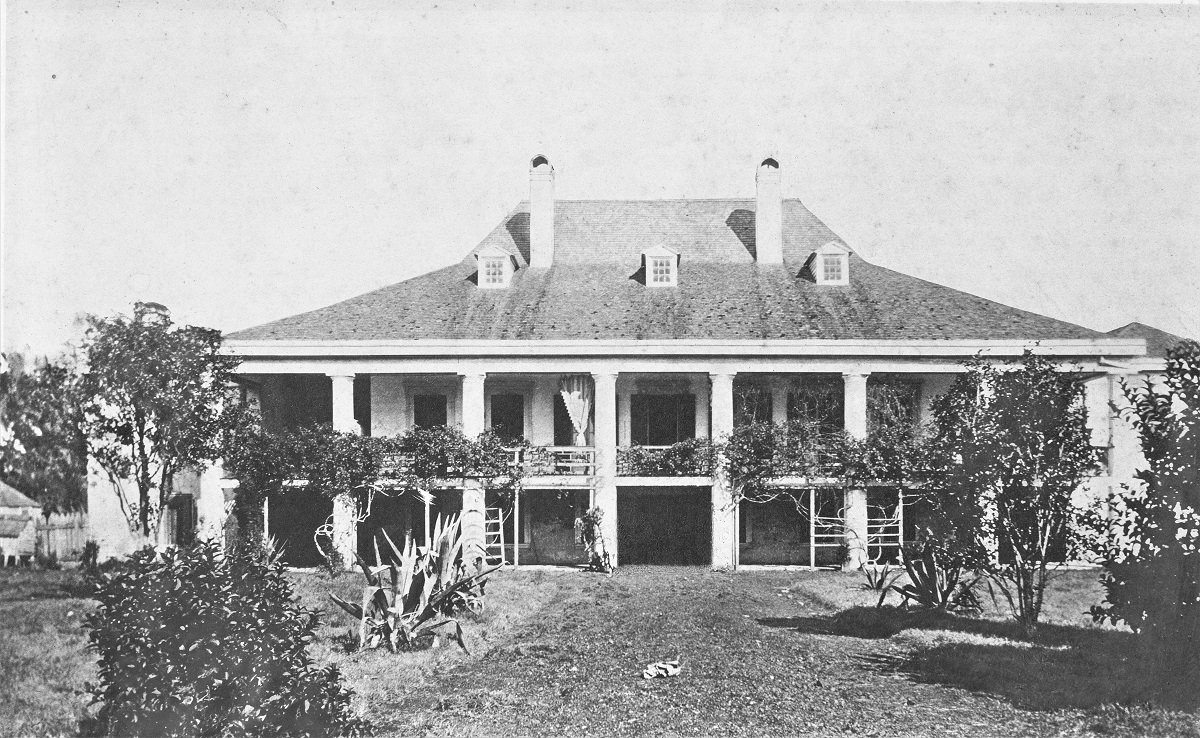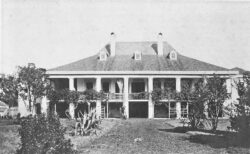Home Colonies
After the Civil War, the federal government briefly operated places of refuge for sick, injured, and elderly formerly enslaved people that proved both benevolent and coercive.

River Road Historical Society
Destrehan Plantation, picture here circa 1865, was the site of the Rost Home Colony.
Home colonies were plantations run by the US government in Louisiana between 1865 and 1866 during the early years of Reconstruction following the Civil War. Federal officials intended for these plantations to provide a place of refuge for sick, injured, and elderly formerly enslaved people, and they established schools and hospitals to help centralize federal aid. However, home colonies also became penal colonies, places to send homeless and unemployed Black men and women who were forced to work and stay unless they could prove employment elsewhere.
At the height of their operation, just over three thousand freed people living on four colonies cultivated almost ten thousand acres of cotton, corn, sugarcane, and other crops. Under immense public pressure to avoid charges of fostering “dependency” among the newly emancipated, federal officials sought to make the home colonies self-sufficient. The colonies were never able to fund their operations through the sale of their products, and only one turned a profit. The sick always outnumbered those fit for labor. By the end of 1865, the government closed all but one home colony in Louisiana, and the final colony closed a year later. Colony lands were returned to their previous owners.
For two years, the government operated four home colonies in Louisiana at the confiscated plantations of Confederate officials and sympathizers. In Lafourche Parish, the government created a colony at the plantation of Confederate General Braxton Bragg, and in East Baton Rouge Parish, it created a colony at the plantation of James Alexander McHatton. (In the 1920s the McHatton plantation became part of Louisiana State University’s campus and included the land surrounding the Native American earth mounds.) In Jefferson Parish, Daniel T. Sparks surrendered his plantation to become a home colony, and in St. Charles Parish, the government confiscated Confederate diplomat Pierre A. Rost’s plantation, once owned by the family of Rost’s wife, Louise Odile Destrehan. The Rost Home Colony became the most famous, lasted the longest, and was the only colony to turn a profit.
Before the Civil War, enslavers were supposed to provide medical care to the people they enslaved, and they were supposed to care for the few who lived to old age. As the war loosened the shackles of slavery, enslavers absolved themselves of any assumed responsibility for the health of their enslaved workers. They insisted that freed people were the federal government’s responsibility. Freed people asserted their right to proper medical care and looked to the federal government for assistance, particularly when local governments refused to provide care. The federal government took responsibility. First, the US Army administered social services for Black people. After March 1865, the Bureau of Refugees, Freedmen, and Abandoned Lands, or Freedmen’s Bureau took over.
Home colonies owed their existence to Thomas W. Conway, a Baptist preacher from Massachusetts who became a chaplain for the US Army during the Civil War. In the summer of 1865, Conway became the head of the Bureau of Free Labor in the army’s Department of the Gulf, which oversaw military and early Reconstruction operations in Louisiana, Mississippi, Alabama, Texas, and Florida. In that role, he created the home colonies in early 1865. He hoped to solve a problem caused by the war and the end of slavery: how to care for sick, injured, and elderly freed people.
Many freed people entered home colonies voluntarily in search of medical aid and a stable place to live. Home colonies were one of the few sources for health care and education in rural southern Louisiana. Residents received rations and clothing. Colonies were run by officers from the Freedmen’s Bureau and guarded by Union soldiers, many of them Black men who enlisted in regiments of the United States Colored Troops. In an era when racial violence was common, living near sympathetic soldiers could be a lifesaver. On the other hand, freed people were forced to labor unless they were sick, disabled, or injured, and they could leave only if they proved they had a job somewhere else. Some ended up on home colonies instead of going to jail for vagrancy.
Home colonies were short-lived government experiments that blended benevolence with coercion. They existed during a brief moment after the Civil War when the federal government attempted, for the first time, to provide social services to its citizens and took responsibility for caring for elderly, sick, and injured freed people.
